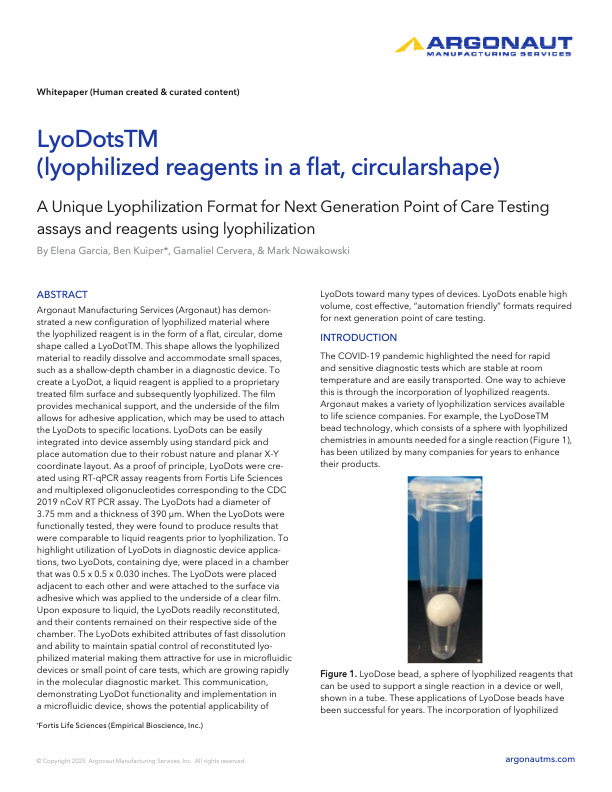The market size of next generation point of care testing is steadily growing and experiencing a significant trend towards miniaturization and portability, enabling healthcare providers to perform diagnostic tests outside of traditional laboratory settings. This advancement allows for faster turnaround times and improved patient outcomes, particularly in remote or resource-limited areas. Additionally, there is a growing emphasis on multiplexing, where a single point-of-care device can detect multiple analytes simultaneously, enhancing efficiency and cost-effectiveness in diagnostic testing.
LyoDots for Next Generation Point of Care Testing
Argonaut has demonstrated a new configuration of lyophilized material where the lyophilized reagent is in the form of a flat, circular, dome shape called a LyoDot. This shape allows the lyophilized material to readily dissolve and accommodate small spaces, such as a shallow-depth chamber in a diagnostic device. LyoDots can be easily integrated into device assembly using standard pick and place automation due to their robust nature and planar X-Y coordinate layout. As a proof of principle, LyoDots were created using RT-qPCR assay reagents from Fortis Life Sciences and multiplexed oligonucleotides corresponding to the CDC 2019 nCoV RT PCR assay. The LyoDots had a diameter of 3.75 mm and a thickness of 390 µm. When the LyoDots were functionally tested, they were found to produce results that were comparable to liquid reagents prior to lyophilization. To highlight utilization of LyoDots in diagnostic device applications, two LyoDots, containing dye, were placed in a chamber that was 0.5 x 0.5 x 0.030 inches. The LyoDots were placed adjacent to each other and were attached to the surface via adhesive which was applied to the underside of a clear film. Upon exposure to liquid, the LyoDots readily reconstituted, and their contents remained on their respective side of the chamber. The LyoDots exhibited attributes of fast dissolution and ability to maintain spatial control of reconstituted lyophilized material making them attractive for use in microfluidic devices or small point of care tests, which are growing rapidly in the molecular diagnostic market. This communication, demonstrating LyoDot functionality and implementation in a microfluidic device, shows the potential applicability of LyoDots toward many types of devices. LyoDots enable high volume, cost effective, “automation friendly” formats required for next generation point of care testing.
Read this white paper to learn more about how LyoDots can help your next generation point of care testing device.
